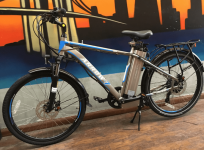galvatron1
100 mW
- Joined
- Jul 15, 2013
- Messages
- 47
Looking for a safe 1st ebike. I've read ES stories of battery fires & have been hesitant. I can't charge in a garage, b/c I'm in an apt. Here are my 2 options I'm considering. Thanks.
Option 1
Arrow-7: http://www.flyebike.com/?portfolio=arrow-7
Speed: 30 MPH
Range: 50 Miles
Battery: 48V/20AH Panasonic Cells
Motor: 500W
Charging time: 6-8 Hrs
Option 2
BBSHD w/ Hailong-3 52v battery pack.
Option 1
Arrow-7: http://www.flyebike.com/?portfolio=arrow-7
Speed: 30 MPH
Range: 50 Miles
Battery: 48V/20AH Panasonic Cells
Motor: 500W
Charging time: 6-8 Hrs
Option 2
BBSHD w/ Hailong-3 52v battery pack.


